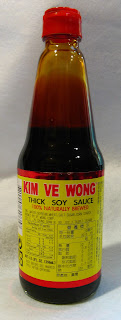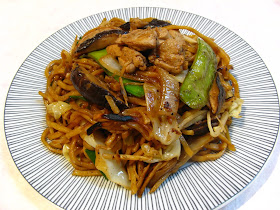I’ve been adding cabbage to my chow mein recipes lately,
probably because a nearby Chinese noodle restaurant does the same to their
dishes. The cabbage adds a nice crunch to the recipe and a good textural
contrast to the soft noodles. Depending upon the size of the cabbage, two to
four leaves are needed for the dish. Other than the added cabbage, the rest of
the ingredients used in this recipe are fairly common in chicken chow mein. This
is a “dry” noodle dish and not a dish with a lot of “wet” sauce.
Enjoy!
Ingredients
|
¾ lb.
|
375 g.
|
Chicken thigh (鷄髀, gai1 bei2) or breast meat (雞胸肉, gai1 hung1 juk6), cut into 1-inch (2.5
cm.) pieces
|
|
1 tsp.
|
5 ml.
|
Baking soda (蘇打粉, sou1 daa2 fan2)
|
|
½ in.
|
15 mm.
|
Knob of ginger
(薑, goeng1), crushed in a garlic
press
|
|
2 cloves
|
2 cloves
|
Garlic (蒜, syun3), crushed in a garlic press
|
|
1 Tbs.
|
15 ml.
|
Corn starch (粟粉, suk1 fan2)
|
|
2 Tbs.
|
30 ml.
|
Soy sauce (豉油, si6 jau4)
|
|
1 Tbs.
|
15 ml.
|
Hoisin sauce (海鮮醬, hoi2 sin1 zoeng3)
|
|
2 Tbs.
|
30 ml.
|
Shaoxing rice
wine (紹興酒, siu6 hing1 zau2)
or dry sherry
|
|
½ tsp.
|
2.5 ml.
|
Ground white
pepper (白胡椒, baak6 wu4 ziu1)
|
|
1 tsp.
|
5 ml.
|
Sesame oil (麻油, maa4 jau4)
|
|
|
|
|
|
½ lb.
|
250 g.
|
Snow peas (荷蘭豆, ho4 laan4
dau6)
|
|
½ lb.
|
250 g.
|
Cabbage (青椰菜, ceng1 je4
coi3), cut into
½-inch (15 mm.) pieces
|
|
10
|
10
|
Dried Shiitake
mushrooms (冬菇, dung1
gu1), rehydrated and cut into ½-inch (15 mm.) pieces
|
|
1
|
1
|
Onion (洋蔥, joeng4 cung1), halved and cut into ½-inch (15
mm.) pieces
|
|
10.5 oz.
|
297 g.
|
One 20 oz. (566
g.) can bamboo shoot strips (筍, seon2), drained, or use fresh if available
|
|
½ lb.
|
250 g.
|
Bean sprouts (芽菜, ngaa4 coi3)
|
|
3 stalks
|
3 stalks
|
Green onions (葱, cung1), cut into 1-inch (2.5 cm.) pieces on the diagonal
|
|
½ in.
|
15 mm.
|
Knob of ginger
(薑, goeng1), crushed in a garlic
press
|
|
2 cloves
|
2 cloves
|
Garlic (蒜, syun3), crushed in a garlic press
|
|
1 lb.
|
500 g.
|
One package chow
mein noodles (炒麵, caau2 min6)
|
|
|
|
Oil for cooking
|
Sauce Ingredients
|
2 Tbs.
|
30 ml.
|
Kim Ve Wong brand Thick Soy Sauce (膏油醬, gou1 jau4 zeong3) or
equivalent, or dark sauce (老抽, lou5
cau1)
|
|
2 Tbs.
|
30 ml.
|
Soy sauce (豉油, si6
jau4)
|
|
1 Tbs.
|
15 ml.
|
Hoisin sauce (海鮮醬, hoi2
sin1 zoeng3)
|
|
2 Tbs.
|
30 ml.
|
Shaoxing rice wine (紹興酒,
siu6 hing1 zau2) or dry sherry
|
|
½ tsp.
|
2.5 ml.
|
Ground white pepper (白胡椒,
baak6 wu4 ziu1)
|
|
½ Tbs.
|
7.5 ml.
|
Sesame oil (麻油, maa4
jau4)
|
Equipment
|
|
|
Garlic press
|
|
14 in.
|
35.5 cm.
|
Wok or pan
|
 |
| Kim Ve Wong Brand Thick Soy Sauce (膏油醬, gou1 jau4 zeong3) |
Preparation Instructions
- Prepare the chicken thigh or breast meat by removing any bones, excess fat, and skin. Cut the chicken into 1-inch (2.5 cm.) pieces. Wet with water and add baking soda to the chicken, allow to tenderize for 15 minutes, and then wash the baking soda from the meat. The baking soda can be omitted but results in the tender meat experienced in restaurant dishes.
- Marinate the chicken in a covered container for at least one hour or overnight in the refrigerator with the ginger and garlic crushed in a garlic press, corn starch, soy sauce, hoisin sauce, Shaoxing rice wine or dry sherry, ground white pepper, and sesame oil. If marinating the chicken overnight, take it out of the refrigerator at least one hour before cooking.
- Pour boiling water over the dried Shiitake mushrooms in a heat proof bowl and rehydrate the mushrooms for at least one hour. Remove the Shiitake mushrooms from the rehydration liquid, remove the stems, and cut them into ½-inch (15 mm.) pieces. Reserve the rehydration liquid for later use in the cooking process.
- Remove the tough outer skin of the onion and cut in half lengthwise. Cut each half into ½-inch (15 mm.) pieces).
- Wash and cut the cabbage into ½-inch (15 mm.) pieces. Depending upon the size of the cabbage, two to four leaves should be enough for this dish.
- Wash and cut the long beans into 2-inch (5 cm.) pieces.
- Wash and remove the string from the snow peas by grasping each snow pea in one hand and pulling the tip the length of the snow pea with the other.
- Open and drain the can with the bamboo shoots, or use fresh if available (wash first). Remove as much water as possible to facilitate stir frying.
- Wash the bean sprouts and remove as much water as possible to facilitate stir frying.
- Crush the ginger and garlic in a garlic press and put into a small bowl.
- Wash and cut the green onions into 1-inch (2.5 cm.) pieces on the diagonal.
- Prepare and mix the sauce in a small bowl: add the Kim Ve Wong brand Thick Soy Sauce (or equivalent) or dark soy sauce, soy sauce, hoisin sauce, Shaoxing rice wine or dry sherry, ground white pepper, and sesame oil.
Cooking Instructions
- Cook the noodles according to the instructions on the package and until the noodles are al dente. Drain the noodles and set aside. If using thawed, ready-made, or fresh noodles, “fluff” the noodles to separate them (i.e. you don’t want put a single mass of noodles into the wok).
- Heat a wok or pan over high heat before adding oil. Add the chicken pieces to the wok in a single layer on the bottom and brown the outside. You may have to cook the chicken in batches, so be sure to reheat the wok over high heat before adding more oil. Transfer the chicken to a bowl.
- Reheat the wok over high heat before adding oil and then the Shiitake mushrooms. Stir fry the mushrooms and then transfer them to the bowl with the chicken.
- Reheat the wok over high heat before adding oil and then the onion. Stir fry the onion and then transfer them to the bowl with the chicken.
- Reheat the wok over high heat before adding oil and then the cabbage. Stir fry the cabbage and then transfer them to the bowl with the chicken.
- Reheat the wok over high heat before adding oil and then the snow peas. Stir fry the snow peas to brown them. Add the bowl with the ginger and garlic mixture, and then some oil to the mixture. Quickly stir fry all the ingredients until the ginger and garlic mixture becomes fragrant. Transfer the contents of the wok to the bowl with the chicken.
- Reheat the wok over high heat before adding oil and then the bamboo shoots. Stir fry the bamboo shoots and then transfer them to the bowl with the chicken.
- Reheat the wok over high heat before adding oil and then the bean sprouts. Stir fry the bean sprouts and then transfer them to the bowl with the chicken.
- Reheat the wok over high heat before adding more oil and then the noodles. The wok should be very hot before adding the oil and then the noodles. Noodles cooked in a restaurant wok (over much higher heat than that available in your kitchen) are served slightly burned, which gives the noodles an extra added flavor. To try to emulate slightly burned noodles, try to put the noodles in one layer in the hot wok and add some mushroom rehydration liquid (but not too much liquid otherwise you’ll steam the noodles) to facilitate the heat transfer from the wok to the noodles, and leave the noodles alone. You want the noodles to get burned before adding more oil to the noodles and turning them over, repeating the process.
- Add the green onions and the contents of the bowl with the chicken back into the wok, and stir fry all the ingredients together. Add the sauce ingredients to the wok and mix the ingredients together. Put the cooked ingredients into a serving dish and serve immediately.

No comments:
Post a Comment